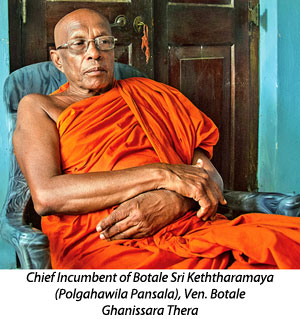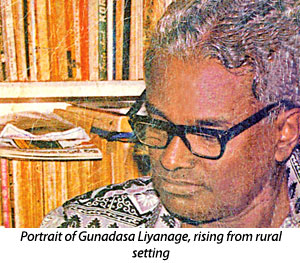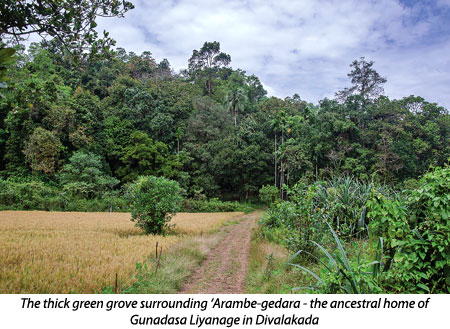
The birth place of Gunadasa Liyanage (Guli to most of his readers), showcases vignettes of his life as the last of the generation of independent journalists describing his eternal love for his rustic village, Divalakada and its simple villagers.

 “Botalegama in the Bulathsinhala electorate, is my birth place. The narrow gravel road starting from the Egaloya junction branches off near the Melwatta temple; one road leads to Yahalawatta ferry via Divalakada and the other stretches out to the Halwatura Plantation through Bothalegama. Across the Halwatura ferry, the road on the other side leads to Ingiriya.
“Botalegama in the Bulathsinhala electorate, is my birth place. The narrow gravel road starting from the Egaloya junction branches off near the Melwatta temple; one road leads to Yahalawatta ferry via Divalakada and the other stretches out to the Halwatura Plantation through Bothalegama. Across the Halwatura ferry, the road on the other side leads to Ingiriya.
“There is no bus service on this road although hundreds of people travel daily. A van owned by Ranasingha Ralahami, of Atura Bus Company runs from Autura to Ingiriya via Botalegama, thrice a day. Although the van has only 12 seats, more than 30-40 passengers travel on it, on each journey.”
I extracted the above paragraphs from Gunadasa Liyanage’s Sinhala novel – ‘Dona Kamalawathi’, one of his best-seller Sinhala novels in the early 70s which described in detail his village Divalakada, and Botalegama.
This week I choose to write about ‘Arambe-gedara’ of Divalakada– a beautiful rustic village, near Botalegama in Bulathsinhala in the Kalutara district, rich in greenery, fresh air and beautiful landscapes. It may sound awkward, but ‘Arambe-gedara’ means a home situated in a grove. It is where the renowned journalist, the late Gunadasa Liyanage was born, on April 22, 1930 and grew up as a village lad. He had his primary education at the Botale Mixed School and later entered Sri Paali College, in Horana to pursue his higher education.
Botalegama and Divalakada are important to me for two reasons – one, Botalegama is where I was born and grew up as a village boy. The second is its adjoining village of Divalakada, where the author and great newspaper editor, Gunadasa Liyanage was born.
Reaching this scenic and nature destination is not only an adventure in itself but also a reminiscence of my nostalgic memories of four decades, as a village lad. Perhaps, it is because I grew up in Botalegama surrounded by mountains and paddy fields, that I am always enticed by them. I visited Divalakada for the first time three decades ago as a boy and used to meet Gunadasa Liyanage at his ancestral home – Arambe-gedara.
I visited Divalakada once again last Monday and found it completely changed, compared to what it was 30 years back. I parked my car on the roadside near Arambe-gedara and walked the few yards crossing the paddy field and reached Arambe-gedara surrounded by a thick grove.
 Liyanage’s son,Vajira a journalist, was busy cleaning the house for an alms giving in commemoration of his late father’s 21st death anniversary to be held on March 17.“ Liyanage’s four children who lived in Colombo, never forgot to visit their father’s legacy frequently and they also visited us whenever they are here,” an elderly villager told me.
Liyanage’s son,Vajira a journalist, was busy cleaning the house for an alms giving in commemoration of his late father’s 21st death anniversary to be held on March 17.“ Liyanage’s four children who lived in Colombo, never forgot to visit their father’s legacy frequently and they also visited us whenever they are here,” an elderly villager told me.
Divalakada, is a historically important ancient village situated in Bulathsinhala. It is mentioned in an ancient chronicle, known as ‘Rajawaliya’. “Some ancient coins were found here and my father gave them to the Department of Archaeology then,” Vajira says, pointing at a thick grove and rocky cave over the mountain. “There are numerous caves hidden in the thick forest over there,” he says.
After visiting Liyanage’s ancestral home, I went to the Polgahavila Pansala, the main temple at Divalakada where I met its chief incumbent Ven. Botale Ghanissara Thera, one of Liyanage’s long time advisors of his auspicious and religious occasions. “Gunadasa Liyanage had a habit of visiting the temple each time he went to the village. He was straightforward and self-confident and stood on his own,” Ven GanissaraThera tells me.
Liyanage loved his rustic village Divalakada and its simple villagers and found a rare peace and quietness there. In the early days, when his mother was alive, he used to come to Divalakada every weekend to visit her and other family members. He constructed a small but beautiful house with quite a large pond full of water lilies in the foothill of a wooded hill where his ancestral home ‘Arambe-gedara stood.
I have witnessed Liyanage accompanied by his family members spending the holidays and enjoying the rural setting of Divalakada. The placid big pond, was a sought after place for Liyanage’s children, especially, the two young ones, Srimath and Vajira. They would jump into the crystal clear waters from the bund to swim and splash. Today, the pond has been overgrown with weeds due to lack of proper maintenance.
My acquaintance with Liyanage began when he was the editor of the now defunct ‘Kalpana’ a Sinhala monthly magazine. Having seen his photographs in the Kalpana magazine, I was greatly impressed. One day, I had the opportunity to meet him in his office on the 5th floor of the People’s Bank Headquarters in Colombo, in the early 80s.
As a schoolboy who had just left school, I thought one of my dreams had come true. He asked me whether I could write a story that could be published in the ‘Kalpana’ magazine. I thought it was a good idea. Eventually, he asked me to work at the magazine office at Deans Road, on a daily basis. My first assignment was a story of a Bhikku who looked after more than 25 stray dogs in the ‘Avasa Ge’ (residence) of the temple known as Sri Gangaramaya at Devamulla near Govinna close to Horana. As an experienced photographer, he taught me how to take photographs of dogs, using a black and white film roll to get maximum contrast of light, showcasing his ability not only of scribbling but also of photography. While working at Kalpana I wrote a few stories in Sinhala with my own photographs. This is one of the small incidents that showed his readiness to welcome and guide a newcomer. He always helped novices to widen their horizons in the field of journalism.
The name Gunadasa Liyanage needs no introduction in Sri Lanka’s literary world. During his lifetime he has boosted the publishing of literary works of ordinary men and women, whose lives were made extraordinary with his pen.
Liyanage’s writings were simple, with much insight and sincerity, with a touch of psychology. His stories portrayed characters in all their glory, with humour and satire; he brought out the reality of their lives in a small rural village.
Liyanage rose to become the Editor-in-chief of a few newspapers, and magazines, such as, ‘Kalpana’ from the ranks of a provincial reporter. This was due to his perseverance and commitment to journalism. Working under the well known newspaper editor, D.B. Dhanapala, he excelled in both Sinhala and English languages in the field of journalism and was once Sri Lanka’s correspondent of the now defunct ‘Asiaweek’ newsweekly published in Hong Kong. He also excelled in the field of broadcasting and television in the recent past.
Three decades on, time has changed everything but memories still exist at ‘Arambe-gedara’ in Divalakada.The towering trees surrounding Arambe-gedara still loom in the backdrop of lush greenery. But, the voice of Gunadasa Liyanage still reverberate in the hearts of the villagers of Divalakada. Gunadasa Liyanage, a dreamer in the real sense passed away 21 years ago at the age of 68, leaving a bright and indelible impression on both Sinhala and English journalism in the media world.
